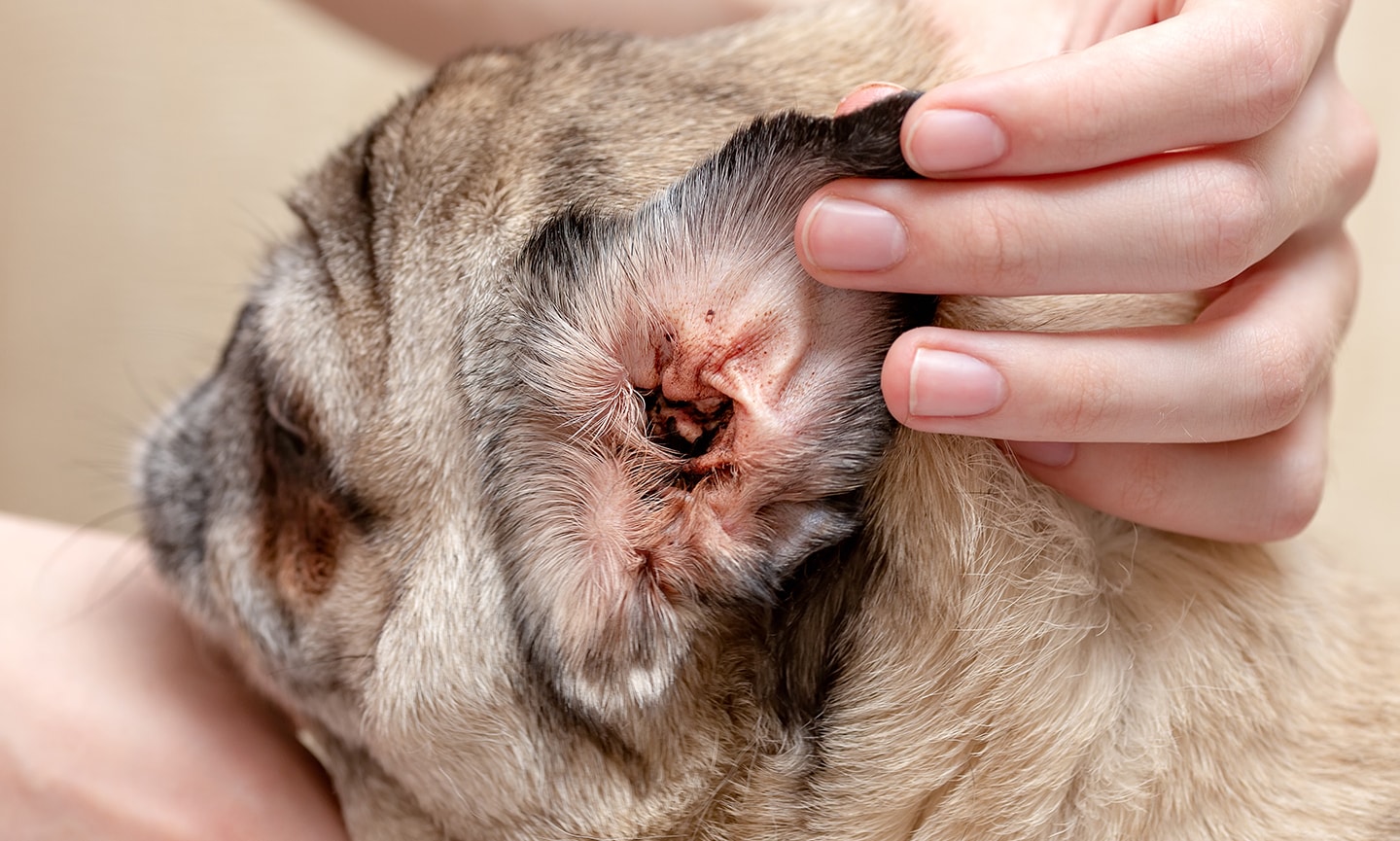What Are Ear Mites in Dogs? And How Do You Get Rid of Them?

Photo by kobkik/iStock/Getty Images Plus
While yeast and bacteria are frequently to blame for dog ear infections, an infestation of ear mites can lead to similar symptoms, including head shaking and scratching their ears and head. Read on to discover how dogs get ear mites, how you can get rid of these tiny parasites, and what you can do to help prevent them from bothering your four-legged bestie.
What Are Ear Mites in Dogs?
Ear mites are parasites that feed off skin oils and ear wax, along with other materials found in and around a dog’s ears. Though tiny, mites can cause quite a bit of discomfort and irritation for your pup. Dog ear mites are related to ticks and spiders; they are all arachnids. By far, the most common type of ear mite in dogs is Otodectes cynotis.
How Do Dogs Get Ear Mites?
Kittens are the most frequent target of ear mites, but our canine friends are certainly not immune. Ear mites are highly contagious between cats, dogs, and ferrets. Our pets get ear mites by coming into contact with other animals who have ear mites.
Kittens, puppies, and pets with compromised immune systems are often at higher risk for developing ear mite infestations compared to adult pets with mature and healthy immune systems.
Signs Your Dog Has Ear Mites

Przemysław Iciak/iStock/Getty Images Plus
Pet parents will often first notice that a dog with ear mites exhibits the following two symptoms:
- Shaking their head
- Scratching their ears and head
Other signs a dog has ear mites include:
- Discharge around the ears that resembles coffee grounds
- Red and swollen skin in and around the ears
- Hot spots/open sores (from all that scratching)
Keep in mind that the symptoms of ear mites in dogs are similar to those seen with other, more common ear problems, like yeast and bacterial ear infections. It’s important to see your veterinarian if you suspect your dog has any sort of ear infection so you can get a proper diagnosis and treatment plan.
What Do Dog Ear Mites Look Like?

Evgenia Glinskaia/iStock/Getty Images Plus
Ear mites are barely visible to the naked eye. You can increase your chances of finding them by taking a chunk of debris from your dog’s ear, placing it on a dark, well-lit surface, and looking at it with a magnifying glass or taking a video that you can enlarge. Under these conditions, ear mites will look like tiny, white moving specks.
What do dog ear mites look like under higher magnification? Think fat ticks with short legs. Veterinarians can easily see them using a microscope or otoscope. (Otoscopes are those handheld devices that doctors use to look into the ears, kind of like little flashlights—you’ve probably seen them at your own doctor’s visits).
How To Get Rid of Ear Mites in Dogs
The safest, simplest, and most effective dog ear mite treatments are available through your veterinarian. First, your vet will confirm that ear mites are actually the cause of your dog’s symptoms. They’ll do this by examining your dog’s ear canals with an otoscope. They may also look at a sample of ear debris under the microscope.
Then, your vet will discuss treatment options with you. These may include:
- A thorough cleaning at the vet
- Prescription ear drops and medications such as Revolution, Advantage Multi, Simparica, and Bravecto
- Ivermectin injections
Your vet may be able to thoroughly clean your dog’s ears and perform all of the necessary treatments in just a single visit, though sometimes they may send you home with a prescription.
Recommended Products
Home Remedies for Ear Mites in Dogs

Treating ear mites at home with over-the-counter ear drops might also be an option for less severe cases. You’ll want to look for “pyrethrins” as an active ingredient and closely follow the label directions. One example is ADAMS Medication for Ear Mites for Dogs & Cats, which contains relatively low, but still effective, concentrations of pyrethrins and piperonyl butoxide.
(Keep in mind that some dogs are more sensitive to pyrethrins and might have a slight skin reaction. Also, some pyrethrin-containing products should not be used on dogs under 12 weeks of age.)
Tresaderm Topical Solution for Dogs & Cats is another option, but the drops must be put in a dog’s ears twice daily for two to three weeks, making it a much more labor-intensive option.
For both, dosing instructions based on a pet’s weight are printed on the product packaging. Always follow the label directions of whatever product you purchase and talk to your veterinarian if you have questions about the way your pet is reacting to a medication.
In addition to ear drops, you’ll also need to clean out your dog’s ears every few days until no more debris is present. (Psst. You can get the how-to here.) If at-home treatment isn’t successful, make an appointment with your veterinarian.
Mites are highly contagious among dogs, cats and ferrets. For that reason, all susceptible animals in your home must be treated.
Pets without symptoms can often just be given a topical parasite preventive containing an active ingredient like selamectin, moxidectin, fluralaner, afoxolaner or saralaner. Products containing these active ingredients require a prescription from your veterinarian.
It’s also good practice to routinely wash your pets’ toys and bedding with soap and hot water.
Recommended Products
How to Prevent Ear Mites in Dogs
The easiest way to prevent ear mites is to routinely give your dog a flea preventive that also works against ear mites. Revolution (selamectin) is available for use against ear mites, but medications with other active ingredients such as moxidectin, fluralaner and afoxolaner can be prescribed by veterinarians, as well. Many of these products prevent multiple types of parasites, such as fleas, roundworms, and hookworms.
Not sure what you’re looking for? Your veterinarian can help you pick the best option based on your dog’s risk factors. It’s also a good idea to meet with your veterinarian if you want to discuss your overall parasite prevention strategy. With appropriate treatment, your canine companion should soon be feeling better.
Dog Ear Mites FAQs
Are dog ear mites contagious?
Ear mites (Otodectes cynotis) are highly contagious among dogs, cats, and ferrets. All susceptible pets in a household should be treated if one is diagnosed with ear mites. This prevents ear mites from hiding out on one pet and then reinfesting others once treatment has stopped. It’s also a good idea to regularly wash your pets’ toys and bedding in hot water.
Can dog ear mites bite humans?
Under normal circumstances, ear mites do not bite humans. We are not the preferred hosts of Otodectes cynotis ear mites. There have been occasional reports of ear mites infesting peoples’ ears or causing a skin rash, but this occurs very rarely. Talk to your doctor if you think you may have contracted ear mites from your dog.
Are dog ear mites visible?
Ear mites in dogs are visible, but they can be hard to see with the naked eye (though magnification certainly helps!). Take a sample of debris from your dog’s ears and put it on a dark, brightly lit surface. If you see small white specks moving around, those are ear mites. Your veterinarian can easily see dog ear mites under a microscope or with an otoscope.
While dog ear mites are a somewhat common woe for our fuzzy friends, the good news is that they are highly treatable and can be prevented. Next, take a look at the best flea and tick prevention for dogs.
This content was medically reviewed by a veterinarian.

















